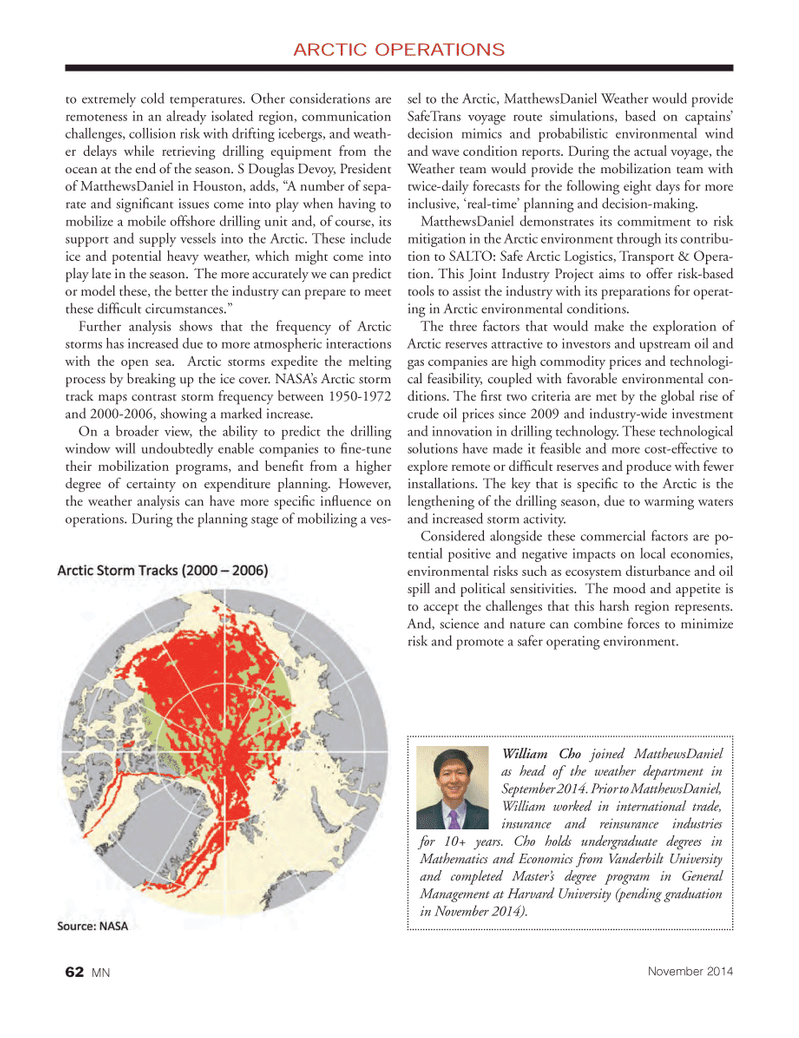
Page 62: of Marine News Magazine (November 2014)
Workboat Annual
Read this page in Pdf, Flash or Html5 edition of November 2014 Marine News Magazine
to extremely cold temperatures. Other considerations are remoteness in an already isolated region, communication challenges, collision risk with drifting icebergs, and weath- er delays while retrieving drilling equipment from the ocean at the end of the season. S Douglas Devoy, President of MatthewsDaniel in Houston, adds, “A number of sepa- rate and signifi cant issues come into play when having to mobilize a mobile offshore drilling unit and, of course, its support and supply vessels into the Arctic. These include ice and potential heavy weather, which might come into play late in the season. The more accurately we can predict or model these, the better the industry can prepare to meet these diffi cult circumstances.”
Further analysis shows that the frequency of Arctic storms has increased due to more atmospheric interactions with the open sea. Arctic storms expedite the melting process by breaking up the ice cover. NASA’s Arctic storm track maps contrast storm frequency between 1950-1972 and 2000-2006, showing a marked increase.
On a broader view, the ability to predict the drilling window will undoubtedly enable companies to fi ne-tune their mobilization programs, and benefi t from a higher degree of certainty on expenditure planning. However, the weather analysis can have more specifi c infl uence on operations. During the planning stage of mobilizing a ves- sel to the Arctic, MatthewsDaniel Weather would provide
SafeTrans voyage route simulations, based on captains’ decision mimics and probabilistic environmental wind and wave condition reports. During the actual voyage, the
Weather team would provide the mobilization team with twice-daily forecasts for the following eight days for more inclusive, ‘real-time’ planning and decision-making.
MatthewsDaniel demonstrates its commitment to risk mitigation in the Arctic environment through its contribu- tion to SALTO: Safe Arctic Logistics, Transport & Opera- tion. This Joint Industry Project aims to offer risk-based tools to assist the industry with its preparations for operat- ing in Arctic environmental conditions.
The three factors that would make the exploration of
Arctic reserves attractive to investors and upstream oil and gas companies are high commodity prices and technologi- cal feasibility, coupled with favorable environmental con- ditions. The fi rst two criteria are met by the global rise of crude oil prices since 2009 and industry-wide investment and innovation in drilling technology. These technological solutions have made it feasible and more cost-effective to explore remote or diffi cult reserves and produce with fewer installations. The key that is specifi c to the Arctic is the lengthening of the drilling season, due to warming waters and increased storm activity.
Considered alongside these commercial factors are po- tential positive and negative impacts on local economies, environmental risks such as ecosystem disturbance and oil spill and political sensitivities. The mood and appetite is to accept the challenges that this harsh region represents.
And, science and nature can combine forces to minimize risk and promote a safer operating environment.
William Cho joined MatthewsDaniel as head of the weather department in
September 2014. Prior to MatthewsDaniel,
William worked in international trade, insurance and reinsurance industries for 10+ years. Cho holds undergraduate degrees in
Mathematics and Economics from Vanderbilt University and completed Master’s degree program in General
Management at Harvard University (pending graduation in November 2014).
ARCTIC OPERATIONS
November 2014 62 MN
MN Nov14 Layout 50-65.indd 62 10/23/2014 10:41:07 AM

 61
61

 63
63
